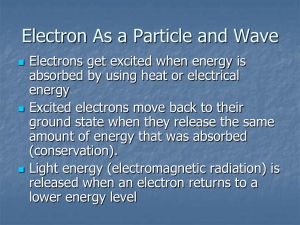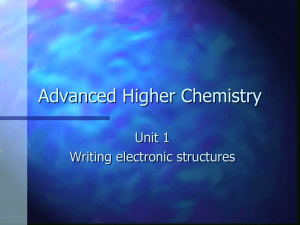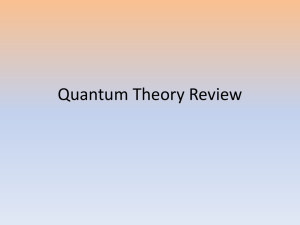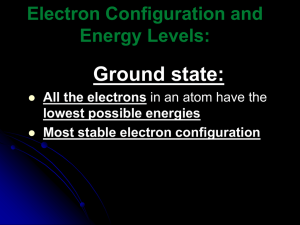Document
advertisement
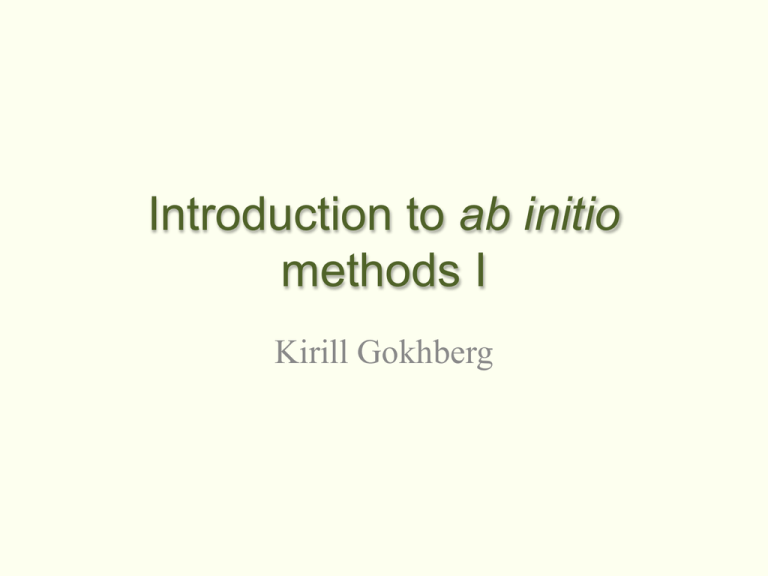
Introduction to ab initio methods I Kirill Gokhberg „We‘ve got fascinating results!“ „ ... this is ICD in the Ar dimer ...“ Anatomy of an ICD process Resonant Auger partial rates Nuclear dynamics in ICD states ICD rates (R) Core-Excited state PEC Satellite Ar+*Ar PEC Final Ar+Ar+ PEC Initial vibrational WP Optical excitation. Dipole TM needed! ICD electron (and KER) spectra Ar2 GS PEC H Te T N U ( r , R ) + relativistic terms if needed. H describes the motion of N electrons and M nuclei. 2 2 pi P , TN Te 2 i 2M Z U ( r , R ) i , | ri R | |r i j i 1 Electron interaction term rj | H H e TN He describes only electronic motion (nuclei fixed). 1. Bound electronic states H e n ( r , R ) V n ( R ) n ( r , R ) Kirill&Andreas PEC or PES Used to obtain the „properties“ :TM, etc 2. Resonance (bound-in-continuum) states V n ( R ), n ( R ) Premysl Electronic widths 3. Nuclear dynamics (in local approximation) (r , R ) n ( R ) n (r , R ) n i T V ( R ) ( R ) E n (R) n n N 2 Nicolas nm m (R) m time dependent formulation + coupling to final states when computing ICD spectra N-electron SE cannot be solved exactly! Approximate solutions are found numerically and two questions should be answered before starting the work. 1. What electronic structure method should we use? 2. How do we represent the respective Hilbert space accurately enough? or What basis set should we select? Choosing a method • Independent particle (mean-field) methods – an electron moves in an average field of (N-1) other electrons. Typical example - Hartree-Fock (HF) approximation. • Correlated methods – a motion of an electron is influenced by (correlated with) the motion of (N-1) other electrons at each instant. Examples – configuration interaction (CI), propagator (ADC), many-body perturbation theory (MBPT), coupled cluster (CC), ... methods. • Hartree-Fock solution is used as an input for the correlated methods. Independent-electron wave function spin-orbital ( x ) (r ) ( ) spin function spatial orbital Slater determinant or molecular orbital (MO) (ground state) 1 0 N ! 1/ 2 N! ( 1) pn P n 1 (1 ) 2 ( 2 ) N ( N ) n 1 •Electrons with anti-parallel spins are uncorrelated. •Electrons with parallel spins are exchange correlated. Hartree-Fock approximation E 0 0 H el 0 0 0 , f (1 ) r (1 ) r r (1 ) f (1 ) h (1 ) J (1 ) K (1 ) E 0 J (1 ) r (1 ) i 1 * 1 d x ( 2 ) r ( 2 ) 2 i 12 i r (1 ) K (1 ) r (1 ) i 1 * 1 d x ( 2 ) r ( 2 ) 2 i 12 r i (1 ) N N HF equations Coulomb and exchange operators N Total electronic energy E HF ih i i 1 1 Coulomb and Exchange integrals Orbital energy Fock operator ij r12 ij 1 ij r12 ji 1 N N 2 i 1 1 1 ij r12 ij ij r12 j 1 1 d x 1 d x 2 i (1 ) i (1 ) r12 j ( 2 ) j ( 2 ) * 1 * d x 1 d x 2 i (1 ) j (1 ) r12 j ( 2 ) i ( 2 ) * * ji Restricted vs. Unrestricted HF • HF recovers up to 99% of the total electronic energy in the ground state corr E exact E HF • However, the energy differences of interest in chemical and spectroscopic processes are a fraction of one percent of the total energy. • For example HF cannot describe binding between two rare-gas atoms Ar dimer electronic ground state EHF=28670 eV, Eint [CCSD(T)]=11.5 meV Koopmans‘ theorem Negative of the HF orbital energies of the occupied MOs are the electron binding energies (ionization potentials). IPi i Photoelectron spectrum of H2O „Breakdown of the MO picture“ due to the intra-molecular correlation Double ionisation threshold Breakdown of monomer lines due to ICD driven by inter-molecular correlation 1. MOs and orbital energies serve as input for the correlated methods. 2. HF approximation furnishes us with a vivid picture of many electron system with electrons stacked on shelves called molecular orbitals. 3. HF solutions are of some, albeit limited, use for computing electronic decay rates. 4. The HF approximation usually does not deliver ground state PES in acceptable quality. It generally fails to produce excited state PES at all. 5. It fails to reproduce correlation driven phenomena. Choosing the basis set M i c ,A i (r R A ) ,A STO N r n 1 G TO N x y z exp( r ) exp( r )Ylm ( , ) •Proper behaviour at r→0 and r→∞. •Small number of STO basis functions are sufficient to represent a MO. l m n 2 •Allow for very efficient computation of four-centre two-electron integals: 1 A B r12 C D dx 1 d x 2 A (1 ) C (1 ) r12 B ( 2 ) D ( 2 ) * 1 * cc-pVDZ basis set for Ne Contracted Gaussian function Primitive Gaussian function (r ) c i i ( i , r ) i Contraction coefficient Contraction exponent Core basis function Valence basis function Polarisation basis function Adding diffuse functions n ( diffuse ) m ax (l ) n RHF calculation of Ne Augmenting a basis set Introducing electron correlation Configuration Interaction scheme cˆ a − creation operator, cˆi − annihilation operator Cˆ I 1ˆ ; cˆa cˆi , a , i ; cˆa cˆb cˆi cˆ j , a , b , i , j ; ... Excitation (N electrons) Cˆ I cˆi , i ; cˆ a cˆi cˆ j , a , i , j ; ... Ionisation (N-1 electrons) Cˆ I cˆi cˆ j , i , j ; cˆ a cˆi cˆ j cˆ k , a , i , j , k ; ... Double ionisation (N-2 electrons) I Cˆ I 0 H IJ I H el J Diagonalisation More on correlation! Andreas‘s lecture tomorrow. E0, E1, ... and corresponding wavefunctions



